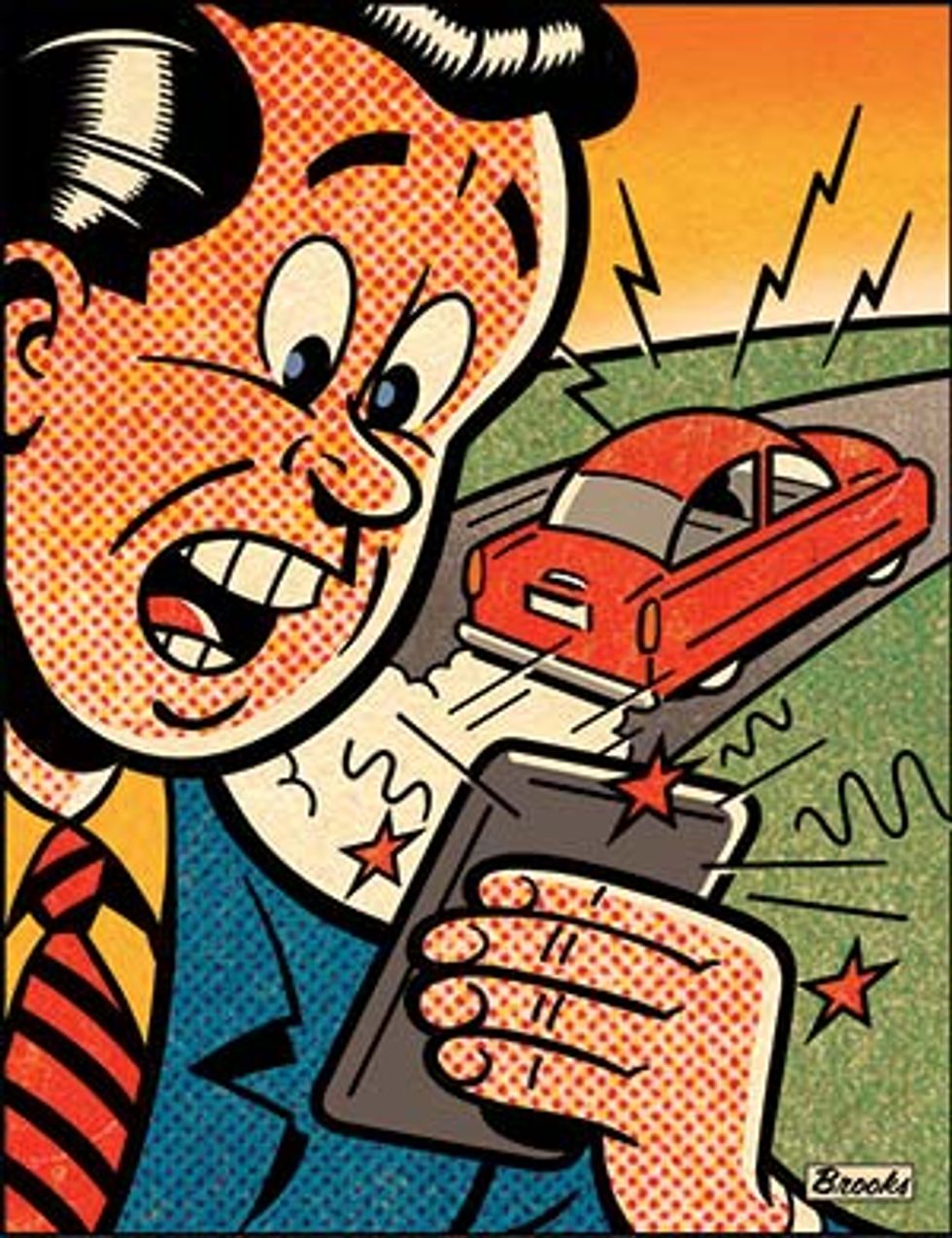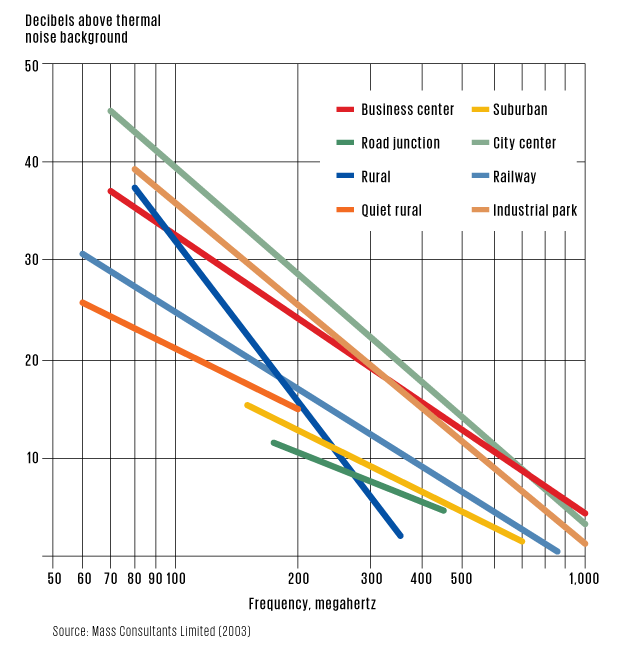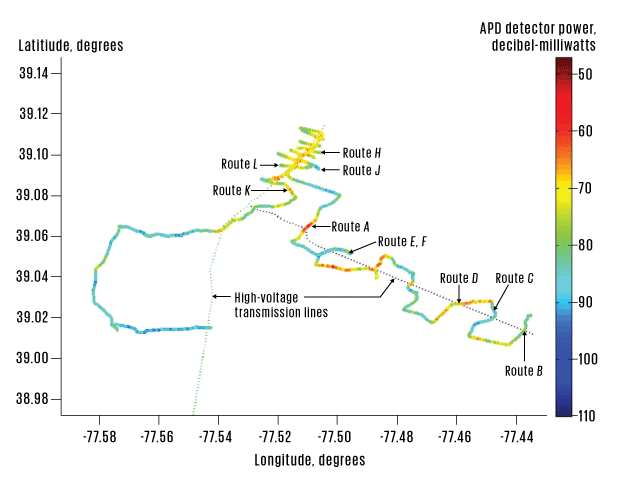Electronic Noise Is Drowning Out the Internet of Things
Our increasingly connected world needs better protection against RF noise pollution

When one of us (Roberson) used to live in Wheaton, Ill., his car’s FM radio would blare static every time he drove near a pole-mounted electrical transformer. Now, when he’s near a particular intersection in Chicago and an elevated train passes by, his mobile phone call gets dropped. The same thing happened to him in a rapid transit station in Washington, D.C., during a conference call with the other two authors of this article. One of them (Matheson) has had to train himself to wait until the commercials begin before turning on his electric toothbrush, because it always breaks up the picture and sound of the TV set in his bedroom.
Radio-frequency noise pollution is everywhere. You can’t see, hear, taste, or smell this noise, of course. Nor can you summon it and study it at your leisure, because it comes and goes along with the movements of its sources or its victims. Start with the fact that any significant digital appliance has a high-speed clock and a digital bus, and both leak radiation profusely. Electric motors and generators generate RF noise with every small spark that jumps between their brushes and spinning commutators. Automobile engines sputter when spark plugs fire. Computers snap and pop during the sharp transitions between ones and zeroes. The high-voltage ballasts of neon signs and fluorescent lights blare a broad mix of frequencies. Industrial machinery, elevators, welders, relays, switching power supplies, even light dimmer switches add to the din. (Of course, natural sources of noise abound as well, including lightning and solar flares, but we will not deal with those problems here.)
The problems of RF pollution fall into four categories. First, it increases the cost of deploying wireless systems while it reduces the battery life of handsets. Second, it creates various levels of interference across a range of frequencies. Third, interference does not—but should—figure in policies on how best to share spectrum, given that the more interference you have, the more spectrum you’ll need in order to transfer a given amount of information. So in practice, wireless channels do not always achieve the data rates they were designed to achieve. And fourth, it is expensive to trace RF pollution to a source and, when you do, it is often challenging to get offenders to stop offending.
The coming Internet of Things is going to make things worse. Much worse. It will do so by adding complex RF-control chips to countless common devices, like door locks, light switches, appliances of every type, our cars, and maybe even our bodies, which will enable them to connect to the Internet. Each of these chips is a potential source of noise. Plenty of technological fixes are available, of course, but the huge number of chips means that manufacturers will be more reluctant to add costly shielding and other noise-muffling features to their products. Silence is golden: It costs money to get it.
The time to start a public dialogue on this question is now. And, having studied the problem for decades, we’re just the guys to do it.

Believe it or not, there hasn’t been a systematic study of radio-frequency noise in the United States since the mid-1970s, when the Institute for Telecommunication Sciences (ITS), a part of the National Telecommunications and Information Administration, last monitored federal use of the radio spectrum. By then, man-made electronic noise had been a problem for nearly half a century, having started with the inauguration of commercial radio transmissions. In 1934, the International Special Committee on Radio Interference was founded in Paris, and that same year a committee with the same mandate was established by the Institute of Radio Engineers, a forerunner of the IEEE. The noise problem grew with the use of electricity and the number of wireless systems, although many details have changed over time.
Only in 1927, with the invention of a method of suppressing RF noise, was it possible to listen to a car radio while the engine was running. By the end of the 1930s, 20 percent of all cars in the United States had built-in radios—which means that 80 percent were presumably not noise suppressed. When the ITS made extensive measurements of RF traffic noise in the mid-1960s to early 1970s, it discovered that many—perhaps most—cars had little noise suppression. Some made so much electrical noise that the men taking the measurements could hear the static from a couple of blocks away.
Today every car has a radio, and the noisy spark-plug problem is gone. The quieting process has continued: In the 1960s, quiet alternators began replacing noisy generators, and electronic ignition started replacing noisy distributors. In the meantime, electronic switches were replacing noisy relays. Electric-drive cars, which would otherwise produce much more interference than standard cars, are sufficiently noise suppressed for cellphones and car radios to work. That same improvement came to the workplace and the home. Early lamp dimmer switches were often electronically noisy; today most are much quieter. Personal computers, too, were redesigned for silence, if only for the sake of their own internal and external wireless data connections.
Nevertheless, the RF noise problem is increasing. Although most devices pollute less than their predecessors, we have far more of those devices. Other sources, such as the power grid, are expanding as wind farms and solar households connect to it. Such devices need to switch large amounts of DC power at a 60-hertz or an even faster rate whenever they feed excess generated power back into the grid. If not done properly, this could also feed large amounts of noise into the power grid. This risk is magnified when the solar and wind systems operate without expert maintenance inside millions of ordinary homes.
At the same time, today’s machines are more sensitive to noise than ever before. Many new wireless systems, including smartphones, are designed to operate with the lowest possible power while still providing their intended function. This means that just a little more noise interference can decrease the coverage area.
Unwanted transmissions can be inherent in the design of a device, such as a microwave oven, whose RF cooking energy also contains a large amount of RF noise. Imperfect shielding can allow this energy to leak out and interfere with other RF devices. Noise can also result from a partial failure in a device—for instance, a tiny break in the ground shield around an insulator in a high-voltage power transmission system. Such a mishap creates an inadvertent transmitter, broadcasting at unpredictable frequencies, in unknown locations and at unexpected times. Complex though these patterns are, we can still often classify the causes of RF pollution by looking at a graph of noise power versus time.

Take the many sources related to arcing over a failed power-line insulator. In the United States, where power frequencies are at 60 Hz, such RF noise typically repeats at a 60-Hz rate (every 16.7 milliseconds) or at a 120-Hz rate (every 8.3 ms). This is because some noise-generating arcing occurs with either a positive or a negative peak line voltage—but not both—and therefore occurs 60 times a second; other arcing processes occur equally well with positive and negative peak voltages. These signatures point the electronic detective to either the power line itself or to a motor, power supply, or other appliance that is connected to it. Indeed, most outdoor man-made noise below 1 gigahertz stems in some fashion from the power grid.
Microwave ovens are another example of what’s generally viewed as a noise generator with a characteristic pattern. In this case, residential microwave ovens are on for half of a 60-Hz cycle and off for the other half, emitting noise into the 2.4-gigahertz spectral band. This is an unlicensed but popular piece of radio spectrum heavily used by low-power nonlicensed devices, cordless phones, and Wi-Fi. Many other electronic appliances, including chargers for cellphones, tablets, and laptops, have switching power supplies that generate noise at the harmonics of the power supply switching frequency, in the hundreds of kilohertz.
Man-made noise levels are much higher in cities than in suburbs or out in the country because cities have a higher concentration of all forms of electrical equipment, computers and radios, and home appliances and systems, as well as industrial equipment. And in all these places the noise level, on average, is in inverse relation to the frequency, because the impulsive source mechanisms generate additional power at lower frequencies.
To map the extent and variation in RF noise in a typical U.S. suburb, we outfitted a car with a roof-mounted antenna, a GPS receiver, and a small, well-shielded, custom-made spectrum measurement system. We drove the car through northern Virginia, on a route that crossed both high- and low-voltage transmission lines. We covered an area about 10 kilometers square.
We set the receiver at 10 frequencies, from 100 to 1,500 megahertz, that coincided with no known intended signal. In each case we measured the signals within a bandwidth of 0.7 MHz for a measurement duration of 55 ms. After measuring the highest frequency, we began again with the lowest frequency. To detect noise from the switching of a power supply, we looked at variations in the noise amplitude of around 100 kilohertz; to detect noise from power lines, we looked at variations in the noise amplitude at 60 or 120 Hz.
We could drive along a high-voltage transmission line for quite some time without detecting much RF noise, but the hot spots we found turned up at random. This implies that there was no systemic cause of the noise, no inherent problem with the design. A defective part—perhaps a loose nut or a cracked insulator—might be arcing. If the power companies did the maintenance, such noise wouldn’t be a problem, but generally they repair such defects only if someone complains.

In our sample, the probability of detecting significant noise outdoors near a high-voltage line was a bit more than 10 percent at frequencies above 500 MHz. About 100 meters from such a line we measured surprisingly high noise levels, in some cases translating to almost 60 decibels (or a million times) greater than the normal background level of thermal noise (a theoretical minimum noise for everyday radio systems).
Our modest experiments offer just a basic sense of how RF noise is distributed in a suburban setting. Surprisingly, and unfortunately, nobody has made a complete and statistically reliable measurement of RF noise since the ITS did so more than 30 years ago. Noise can change significantly over time, locations, frequencies, and operating circumstances. For example, at frequencies above 100 MHz—where older models suggest no noise should be found—our limited measurements showed rather a lot of it.
The bottom line is, no one really knows whether outdoor noise has increased or decreased in recent years—and the same goes for measurements made indoors, where many wireless devices are found today. In fact, the question of noise levels inside buildings is particularly bothersome. The average middle-class home is now full of noise-generating electronic devices, like that electric toothbrush we mentioned. This includes laptop power supplies, power tools, LED light controls, and defective electronic equipment.
Let’s say that RF noise is wreaking havoc with your cellphone reception. How would you know it? That’s just the problem. You probably wouldn’t.
Modern emitters of radio signals, with their exotic digital modulation schemes, don’t usually leave a clue as to exactly why they’re malfunctioning. Older systems were much more transparent: “That sounds like a car engine interfering with my signal.” And automatic error correction or retransmission schemes may completely hide the interference from the user. The only hint of its existence may be a reduction in performance or that the battery in your cellphone goes dead faster than it should. Therefore, even if we had a rich database of consumer complaints—and we don’t—it might not help us get to the bottom of things.
To begin to solve the problem, we need to amass statistics on a broad scale. We have to determine where and when RF noise usually appears and at what frequencies, in each case tracing it to its source. We need samples in many regions to account for differences in equipment and practice, building codes, weather, and terrain.
We know a man who built a new house with LED lights in his kitchen ceiling that were connected to a dimmer switch. Several of his neighbors in a town near Boulder, Colo., began to notice that their garage door openers sometimes weren’t working very well. After several weeks, the man established a clear correlation between the neighbors’ garage doors and his kitchen lights. After trying and failing at several attempts to fix the problem, he just replaced the dimmer switch with a simple on-off switch, and the noise apparently disappeared. Nobody made any measurements, and the local Federal Communications Commission office did not want to know about it. Was this a faulty dimmer switch or just a poor installation? If the switch itself was to blame, then are millions of these dimmers causing interference in the United States and throughout the world? Who knows?
If we had the relevant noise database in hand, it would be theoretically possible to revise today’s regulatory standards and even to extrapolate, from the data, how those standards will have to change a decade from now. The hard part here will be in establishing a reasonable balance between the costs and benefits of such standards. However, the needed data is almost totally missing because we have only a very small database to work from—ours, basically—and we can’t prove whether or not the problem is widespread.
One change that’s clearly needed is in the way the regulators in most countries divvy up the electromagnetic spectrum. Today regulators tend to worry only about interference from an identified transmitter—say, a radio station—while ignoring noise. Yet noise can be far worse than the identified interference.
Regulators should decide this question, at least in part, by considering how much the communications of today’s users would be degraded if new users were allowed to share in the spectrum. This will help to achieve the best trade-off between having some RF pollution that causes minimal interference due to spectrum sharing versus the expectations of empty spectrum.
Even if you’ve never lost a television signal to an electric toothbrush or a cellphone call to a malfunctioning transformer, you still shoulder some of the cost of such noise pollution. That’s because you depend on wireless systems—and those systems must be engineered to handle ever-increasing levels of noise. The problem only grows with the proliferation of electronic devices and the ever-finer sharing of smaller and smaller pieces of the spectrum. No masterstroke can quell noise. Because the problem has to do with both design and maintenance, it incorporates an element of chance, and it is difficult to isolate from other causes of interference.
Our lack of the most basic data on the extent of the problem is unacceptable. We need that data and also a better understanding of the role that noise plays in wireless communications before we can strike the right balance between the costs and benefits of noise suppression. With the exponential increase in the number of noise-generating devices and of wireless systems, RF pollution will become a very expensive problem—unless we act now.
This article originally appeared in print as “Phone to Fridge: Shut Up!”
About the Authors
Mark A. McHenry is the founder of Shared Spectrum, which aims to tackle radio-frequency interference by automating ways to share the spectrum. Dennis Roberson teaches at the Illinois Institute of Technology. Robert J. Matheson, surveyed electronic noise for the federal government back in the 1970s.